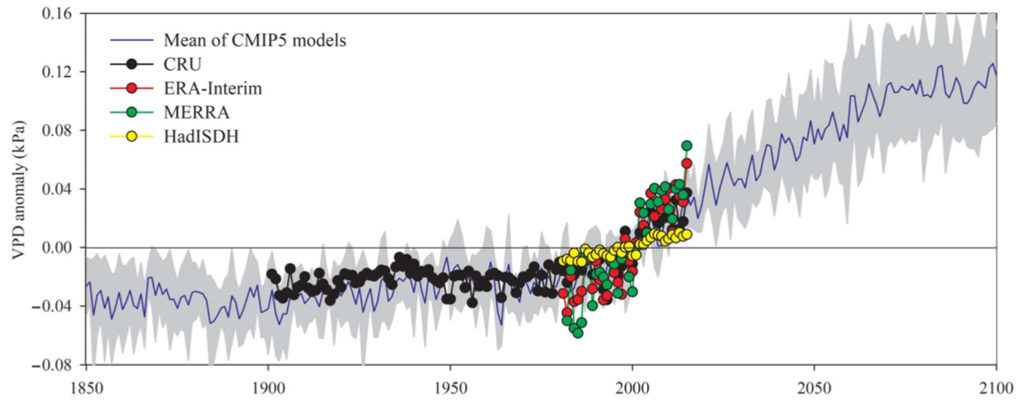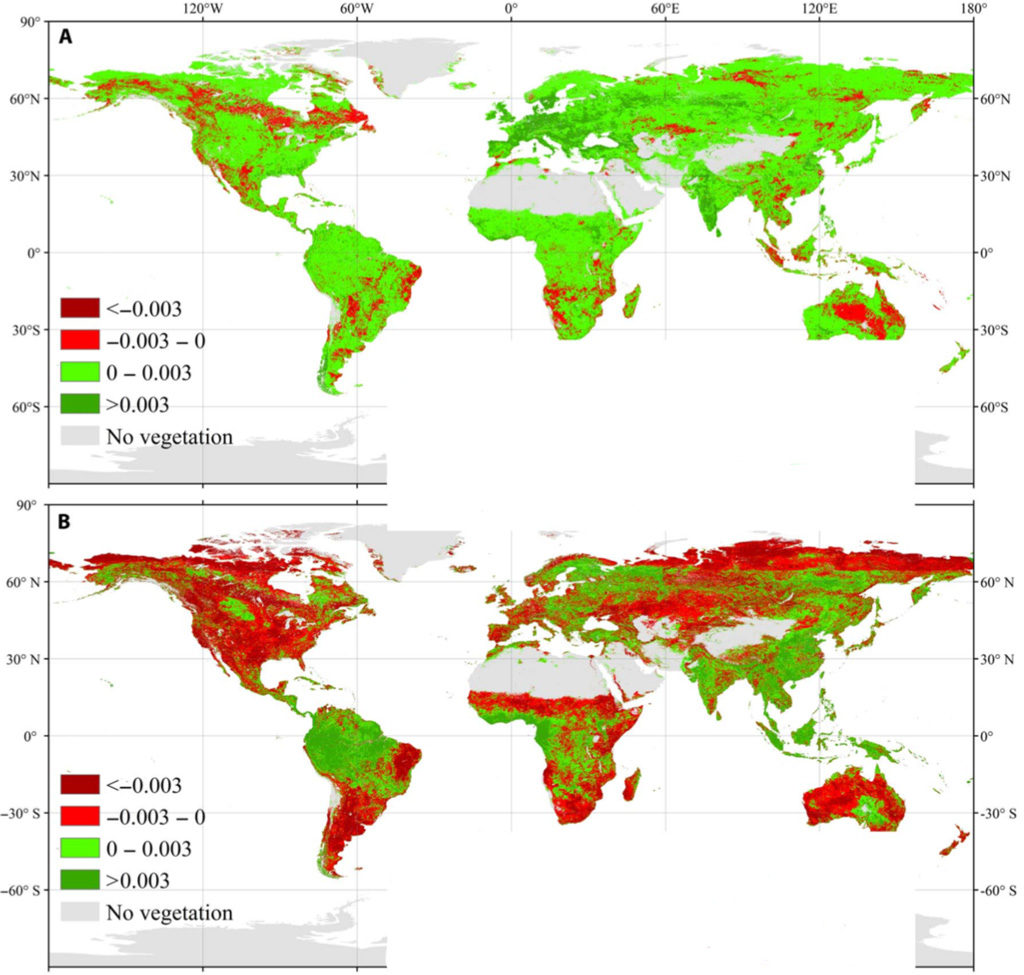
Rising water stress could counteract ‘global greening’, study says
Daisy Dunne
08.14.19Daisy Dunne
14.08.2019 | 7:00pmThe increased growth rate of plants seen worldwide in response to rising CO2 levels – a phenomenon known as “global greening” – could be stalled by growing water stress, a study finds.
Global warming is driving changes to water vapour levels, the research finds, which could, in turn, be affecting the rate of plant photosynthesis – the process underpinning plant growth.
The findings suggest that, in the future, the ability of plants to absorb the CO2 emitted by humans may be “substantially reduced”, the lead author tells Carbon Brief.
At present, the land takes in 30% of the greenhouse gases emitted by humans, according to a recent landmark report by the Intergovernmental Panel on Climate Change (IPCC).
The findings “do a credible job of bringing the increasing water stress on plants to the fore”, another plant scientist tells Carbon Brief.
Turning green
Research using satellites and on-the-ground measurements shows that the world has been getting “greener”. That is, both the rate at which plants are growing and the amount of land covered by plants has increased since the start of the industrial revolution.
This “global greening” has been driven largely by rising CO2 levels in the atmosphere. Plants use CO2 during photosynthesis and so, as humans have emitted more and more CO2, plants have grown at an increasingly rapid rate.
The impact of rising CO2 levels on plant growth is known as the “CO2 fertilisation effect”. A study published in 2016 found that CO2 fertilisation is responsible for around 70% of global greening. (However, a more recent study covered by Carbon Brief questioned the extent to which CO2 fertilisation is responsible for global greening.)
Understanding what is driving global greening and how this could change is important because the phenomenon plays a key role in removing CO2 from the atmosphere.
The land currently absorbs around 30% of the greenhouse gases emitted by humans, according to the IPCC’s recent land report, with plants being responsible for the majority of this land carbon.
Previous research has suggested that, as CO2 levels rise, plant growth rates will continue to increase – meaning more carbon is taken up by the land with time.
However, the new study, published in Science Advances, finds that rising water stress levels could be counteracting the CO2 fertilisation effect, says study lead author Prof Wenping Yuan, a global change ecology researcher from Sun Yat-sen University in Guangdong, China. He tells Carbon Brief:
“Global vegetation growth was enhanced before the late 1990s – benefiting from the CO2 fertilisation effect. However, our study shows that global vegetation growth has shown a decreasing trend since the late 1990s, when the global [water vapour changes] started to increase.”
Vapour’s value
For the study, the authors looked at a measure called the “vapour-pressure deficit” – or VPD.
This measure is the difference between the amount of water vapour in the air and the point at which water vapour in the air becomes saturated. The measure gives an idea of the “water potential” in the atmosphere, Yuan explains:
“Basically, if the water potential is larger in the atmosphere – as in, if VPD is larger – water will dissipate faster and stronger from soil and plants.”
Plants react to higher VPD by closing their stomata – the pores plants use to absorb gases needed for photosynthesis – in order to prevent water loss, Yuan says. This causes them to conduct photosynthesis at a slower rate and, so, grow more slowly, he says.
Increased VPD also causes plants to dry out faster and thus can play a role in drought-related forest death, the study adds.
To explore how VPD has changed in recent decades, the authors analysed several global climate datasets. They looked specifically at VPD of areas with vegetation.
They found that VPD of vegetated areas has increased “strongly” since the late 1990s. The chart below, taken from the study, shows how VPD has increased from 1850 to present day. On the chart, colour is used to show the results from the different climate data sets.

Global mean vapour pressure deficit anomalies (VPD) of vegetated areas from 1850 to present day. Anomalies are relative to the mean of 1982-2015. Colour is used to show the results from the different climate data sets. Blue line and grey area illustrate the mean and standard deviation of VPD simulated by climate models using the scenario “RCP4.5”. Source: Yuan et al. (2019)
The authors also find that VPD of land with vegetation is likely to keep rising in the future.
Increasing VPD is likely being influenced by climate change, Yuan says.
The level at which water vapour in the air becomes saturated is rising as a result of warming temperatures, he explains. (This is because warmer air can hold more moisture.)
However, at the same time, the amount of water vapour in the atmosphere is decreasing. This could be because the amount of water evaporating from the world’s oceans is declining, according to the new study. Yuan says:
“Global warming can decrease wind speed, which, in turn, decreases the water evaporation from the ocean surface.”
This means that the deficit between the amount of water vapour in the air and the level at which water pressure in the air becomes saturated is growing ever larger as the climate changes, he says.
Green to brown
For the next part of the study, the authors used satellite data to observe how global plant growth rates have changed since the 1990s.
The maps below, taken from the study, show how the rate of greening changed in parts of the world between 1982-1998 (top) and 1999-2015 (bottom). On the maps, red indicates that the rate of greening decreased in the period, while green indicates that the rate increased.

Rates of greening across the world between 1982-1998 (top) and 1999-2015 (bottom). Red indicates that the rate of greening decreased in the period, while green indicates that the rate increased. Grey shows land without vegetation. Source: Yuan et al. (2019)
The maps indicate that there have been “persistent and widespread decreases” to the rate of greening since the late 1990s, the study says.
The researchers then used modelling to tease apart the factors that could have driven plant growth decreases since the late 1990s. Yuan says:
“The results show the increasing VPD since the late 1990s is a dominant cause for decreased vegetation growth.”
Shrinking sink
In the future, climate change is likely to cause VPD to increase further – which could have even larger impacts on the rate of plant growth, Yuan says:
“Decreased rates of vegetation growth will substantially reduce the ability of plants to absorb atmospheric CO2. The CO2 concentration in the atmosphere will increase, if other conditions did not change, which will result in a stronger greenhouse gas effect.”
Previous research has shown that the CO2 fertilisation effect could be further constrained by limits to soil nutrient availability. In particular, a lack of nitrogen and phosphorous could limit plant growth as CO2 levels rise.
The new study did not consider how changing nutrient availability could affect plant growth. However, in comparison to nutrient availability limitations – which are likely to remain steady over time, water stress could continue to increase as the climate warms, Yuan says:
“Our results find that VPD will continuously increase until the end of this century with climate warming and, therefore, the impacts of VPD will get more important.”
The findings highlight the threat that water stress poses to plants and, so, the land sink, says Prof Ranga Myneni, a researcher of global greening from Boston University, who was not involved in the study. He tells Carbon Brief:
“Water stress will lead to browning, especially in tropical and boreal forests. In the latter, such climatic changes encourage fires and insect outbreaks, which we have seen during the past 20 years. The authors do a credible job of bringing the increasing water stress on plants to the fore.”
Yuan, W. et al. (2019) Increased atmospheric vapor pressure deficit reduces global vegetation growth, Science Advances, https://advances.sciencemag.org/content/5/8/eaax1396
-
Rising water stress could counteract ‘global greening’, study says
-
Rising water stress could ‘substantially reduce’ land carbon sink

